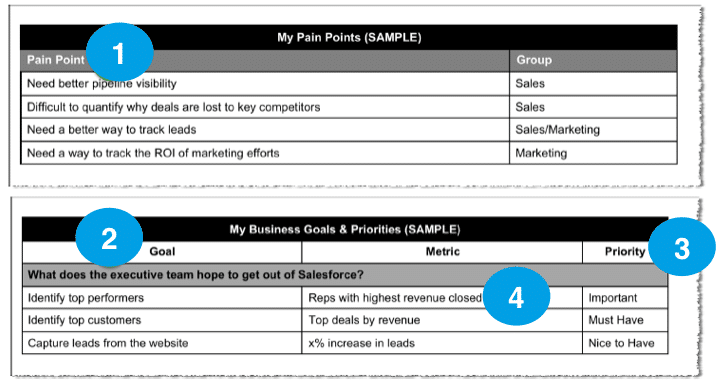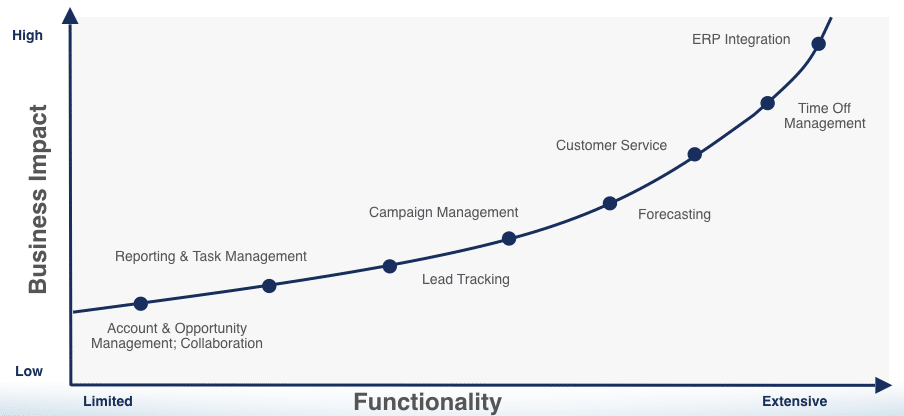The implementation of your Salesforce solution is a lot like building a house: you wouldn’t go straight to picking out furniture and plop it down on an empty plot of land! You need to lay a foundation, build walls and a roof, and set up electricity and plumbing before you can move in. It is only then that you can enjoy the luxury of sitting on the couch in your living room.
The Salesforce platform is a powerful and highly customizable tool that can drive unbridled value into your organization. But for those same reasons, the implementation of Salesforce can be a complicated and confusing endeavor without the right knowledge. Just like when building a house, you need to follow a step-by-step process with your Salesforce solution to ensure that the solution is planned, configured, and set up to scale with your business as you grow.
To help you realize success with your Salesforce solution, we have identified four key components to a proper implementation: 1) prepare, 2) configure, 3) engage, and 4) extend. To break things down into a digestible format, we will focus on the first step ‘Prepare’ in this blog. Watch for the other blogs in the series which will dive into Configuration steps, Engaging Users, and Extending the Platform.
How do you prepare for implementation?
Let’s take our house analogy again. To construct a house, you want to have a clear vision in mind. You want to hire an architect that understands and shares your vision. You want to make sure you have the resources to purchase the proper materials. And, lastly, you want to identify a realistic completion date. In short, building a house is all about planning.
You need to approach the implementation of Salesforce with an action plan to make sure you have the correct expectations and allocated resources to see the implementation through to completion. The preparation step can be broken down into five major activities:
1) Build your team
The people who you appoint to head up your implementation are an imperative precursor to the success of your project. Your team doesn’t have to be massive—you just need to identify a few key personas to bring structure to the operation.
-
- Executive sponsor: The executive sponsor is the champion of the project. He or she will be expected to use their influence to fully support, oversee, and participate in the process from beginning to end.
- Project owner: This person’s job is to manage the project’s timeline and budget, as well as to coordinate communications between all participating members.
- System admin: The system admin acts as a sort of gatekeeper to all new functionality. They are in charge of the day-to-day duties of operating the Salesforce platform, including configuration, application of new features, training, and supporting end users along the way. The system admin is one of the most important roles to guaranteeing a successful implementation.
- Power user: A power user serves as the liaison between the project team and the end users. This person performs beta testing and ensures Salesforce is meeting day-to-day needs of the business.
2) Define your vision
Much like a company’s mission statement, your vision for a Salesforce implementation will highlight your goals and expectations for the project. Your vision will define a clear purpose for your Salesforce initiative, drive ongoing commitment, and provide a way to measure and prove results. Key executives should have a heavy hand in developing this step, but it’s important that the vision is understood and agreed upon by all key team members.
Here is a simple example of a Salesforce vision statement:
“Our vision is to provide our Sales & Marketing team with industry-leading capability to maximize sales effectiveness and productivity, accelerate sales revenue, and make us easier to do business with.”
3) Identify and prioritize business objectives
After you know what you are trying to accomplish, start compiling the existing pain points, goals, and measurements across the teams. This information can often translate to User Stories. Another important step in this process is prioritizing those user stories. You can’t solve every problem at once, so this exercise enables you to understand what you will be addressing first, and what you will be adding to your roadmap.
-
- Pain points: identify the issues that you are currently experiencing.
- Capture goals: These are the outcomes that you hope your Salesforce solution will help you realize.
- Prioritize goals: separate your goals into essential or auxiliary business functions.
- Define measurements: Which parameters do you think will be an indicator of implementation success?

4) Success measurement
Keeping track of your successes is the easiest way to know what’s working and what is not so you can adjust accordingly. These key performance indicators are also the soundest way to justify your investment to stakeholders. Other benefits include the ability to reward desired behavior and ensure the expected value of the end vision. Some dimensions of success measurement include measuring system usage, considering user feedback or employee satisfaction, and assessing company performance as a result of new processes.
5) Create your rollout plan
A lot of companies make the mistake of trying to run before they can walk. The key to a successful implementation is to understand the critical components that will create an immediate impact for users. This will allow users to get incrementally comfortable with the application. From there, you can continue to add additional functionality during later phases.

Defining your plan of attack before beginning your Salesforce implementation is perhaps the most sure-fire way to guarantee a successful rollout. Without it, you will find yourself scrambling to create a cohesive roadmap which builds value for your organization. In the next chapter of this blog series, we will go through the details of configuring your Salesforce instance to meet the requirements outlined in your Prepare phase.















0 Comments